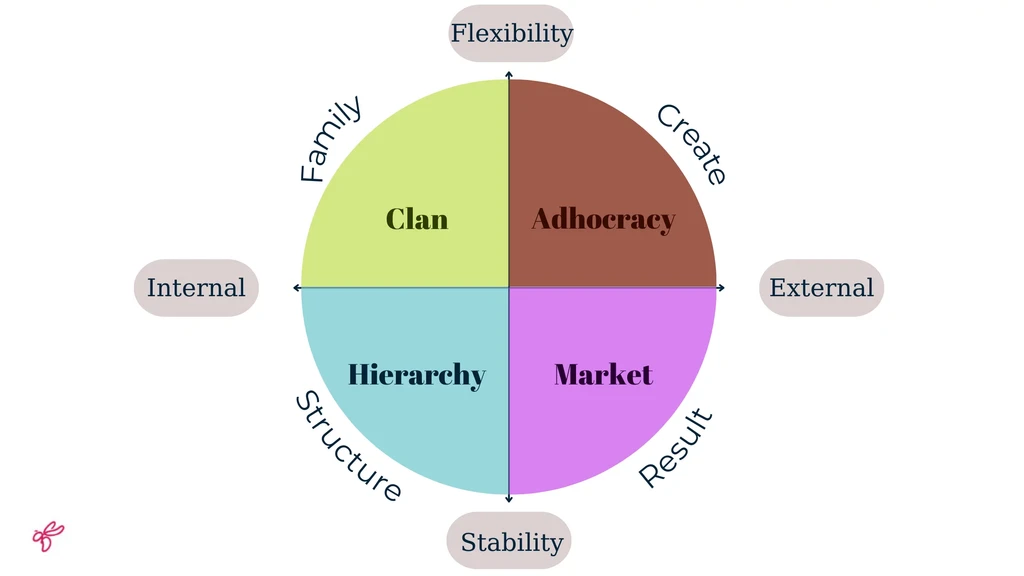4 Basic Types of Company Culture

In today’s business world, company culture is more than a buzzword—it’s the foundation of how organizations operate, connect, and grow. It reflects shared values, behaviors, and traditions that shape the workplace vibe and drive success. From startups to global corporations, a strong culture is essential. In this article, we’ll explore the four main types of company culture, their significance, and how to shape yours for optimal results.
What Is Organizational Culture?
Organizational culture refers to the collective values, beliefs, and behaviors that shape the way employees within a company interact and work together. It’s like the DNA of a business, influencing everything from decision-making processes to how employees dress or communicate.
A strong organizational culture has two main components:
- Visible Elements: These include dress codes, office layouts, and communication styles.
- Invisible Elements: These are deeper, like the values, attitudes, and shared beliefs that drive decision-making.
For example, a tech startup may have a casual dress code and open-office spaces that reflect its values of collaboration and innovation. On the other hand, a law firm might prioritize formality and hierarchy, which is visible through its structured environment and formal communication.

How to Choose and Build a Corporate Culture
Choosing and building a corporate culture requires intentionality and alignment with your organizational goals. Here’s how to approach it:
- Define Core Values: What does your company stand for? Are you prioritizing innovation, customer satisfaction, or sustainability?
- Assess Current Culture: Take stock of your existing cultural norms. What’s working, and what needs improvement?
- Align with Business Goals: Your culture should directly support your organizational objectives. For example, a tech company focused on innovation should cultivate a culture that encourages risk-taking and creativity.
- Engage Employees: Culture isn’t just dictated by leadership—it’s shaped by every member of the organization. Involve employees in discussions and feedback sessions to foster a sense of ownership.
- Reinforce with Policies and Actions: Culture isn’t just talk. Policies, perks, and management actions should reflect your values. For instance, if collaboration is a core value, create open spaces and encourage team projects.
Who Is in Charge of Defining Corporate Culture?
Who sets the tone for your company culture? The truth is, it’s a collective effort, but leadership often plays the most significant role.
- Leaders Set the Vision: Company leaders, from the CEO to middle managers, have the power to define and model cultural values.
- HR Shapes the Framework: HR teams often formalize policies, initiatives, and onboarding processes that reinforce the culture.
- Employees Bring It to Life: Employees actively contribute to culture through their behaviors and interactions. Their engagement can make or break your cultural vision.
Culture is dynamic—it evolves as the organization grows and changes. Leadership should periodically revisit and realign cultural practices to ensure they reflect the organization’s mission and goals.
What Are the Different Types of Company Culture?
The Competitive Values Framework created by Quinn and Cameron in the 1980s states that every company has a unique culture, but these are basically 4 types of culture. The Competitive Values Framework is also a tool you can use to identify your company culture.
The framework has four components; It includes internal focus and integration and external focus and differentiation, stability and control, and flexibility and discretion. In this article, we will examine the types of company culture using this framework.

According to the Competitive Values Framework, there are four basic types of company culture.
1. Clan Culture
Clan culture is especially common in family businesses and organizations with few employees. Hierarchy is not very dominant, titles are secondary, the important thing is to make the organization successful. The atmosphere is dominated by an atmosphere where everyone feels equal and sincere relations are established. Employees have strong relationships with each other, and their job engagement rates are high. An environment similar to the “family” environment is tried to be created. Leaders are seen as “father” or “mentor”. Leadership becomes mentoring. Collaboration is important.
Positive Aspects: Employees feel “belonging” to the organization. Provides a comfortable environment for feedback and expressing opinions, supports open communication, There is a strong bond between employees.
Negative Aspects: Good relationships and a relaxed atmosphere can be abused, an office environment lacking in authority can cause confusion. The work-leisure balance can be disrupted. Most importantly, as the organization grows, there may be difficulties in executing the operation.
Recommendations: The key to maximizing the benefit of clan culture is communication, control and measurement. In order not to abuse a comfortable working environment and unlimited understanding, communicate openly and indicate to your employees what you do not like or do not want. Too much of anything is harmful, provide a warm working environment where your employees will not feel constrained with measured sincerity. Follow how the operation processes are monitored with auditing, and monitor the performance of your employees with business management software such as PeerBie.
2. Adhocracy Culture
It focuses on four basic components of adhocracy culture: speed, innovation, risk taking and creativity. Businesses with an adhocracy culture encourage their employees to take risks and be creative. Adhocracy, which allows individual initiative and freedom, tries to keep the restrictive factors such as bureaucracy and procedure to a minimum.
It is often seen in start-ups and business leaders are innovative entrepreneurs. It is especially suitable for organizations in the field of technology such as Apple, Google and Facebook, where continuous innovation and improvements are required. However, as the organization grows, it becomes difficult to apply adhocracy in each unit, and in time it begins to be applied only in units that maintain innovation and lead the way in the market.
Positive Aspects: For companies focused only on innovation and being a pioneer in the market, it removes the constraining factors such as bureaucracy, encourages employees, develops them by forcing them to take risks and be creative.
Negative Aspects: Employees may experience some problems in a very busy and fast work environment. A chaotic office environment can tire employees mentally. If they do not understand their responsibilities clearly, disruptions may occur in operations. The company may suffer serious financial losses if problems arise during the implementation of bold plans.
Recommendations: Management is very important in organizations with an adhocratic culture. Plans must be carefully formulated and implemented. It is necessary to ensure the management of the workload of the employees, to determine and assign the tasks clearly, and to have continuous communication. Investing in business management software such as PeerBie by companies with an adhocratic culture both relieves the burden of employees and ensures that operational processes run flawlessly.

3. Market Culture
The main goals of the market culture, which started to become widespread in the 1960s, is to always be at the forefront of the race. Organizations with a market culture are focused on tangible results, and there is incredible competition both in the market and among employees. In the market culture of companies such as Oracle, Tesla, and Amazon, the main motivation is to do what no one else has done and put them on the market before anyone else, and to increase the profit rates as much as possible. Customer satisfaction is very important. The entire organization is positioned around the goal of beating competitors. Leaders are very demanding and demanding.
Positive Aspects: Result orientation brings success. One of the characteristic features of market culture is meritocracy. It has a business approach based on merit.
Negative Aspects: Excessive competition can disengage employees and teamwork can bring failure. Since customer satisfaction is in the first place in the market culture, employee satisfaction and experience may be second or even third. Not giving importance to employee’s job satisfaction, excessive competition, constant innovation and success pressure can cause employee burnout.
Recommendations: Emphasis should be placed on areas such as employee satisfaction and satisfaction, strengthening inter-employee relations, and workload management should be properly planned for employee health. With project management tools, the management of the process can be more comfortable. You can listen to your employees with the uninterrupted communication offered by Peerbie.
4. Hierarchy Culture
The most characteristic feature of the hierarchical culture, the most traditional workplace culture, comes from its name. Organizations with this culture have a hierarchical chain of command and all employees know very well where they are in this chain. Organizational structure, control and “doing things right” are among the most important features. Not making mistakes is one of the biggest goals. There is strict adherence to bureaucracy and procedures. There are strict follow-up and strict rules. Relationships are pretty formal. There are layers and distances between the leader and the employee. Duties are clear and responsibilities are assigned according to job level. It is suitable for the administration of large organizations such as army, hospital, oil enterprises.
Positive Aspects: Provides risk management, stability and efficiency. Makes it easy to be organized. Boundaries and tasks are very clearly defined, there is no room for obscurity. Communication is flawless. Everything is done by the book.
Negative Aspects: Not flexible; affected by sudden changes. Strict rules and bureaucracy slow down the process.
Recommendations: Filling gaps in the chain of command and setting goals for each department makes it easier to run things.
The Impact of Company Culture on Business Success
The influence of company culture on business success is immense. It’s not just a soft skill; it’s a competitive advantage.
1. Financial Performance:
Research consistently shows that companies with strong, positive cultures outperform their competitors financially. For example, organizations ranked on “best places to work” lists often see higher revenue growth and profit margins.
2. Innovation and Creativity:
Innovative cultures like those at Google or Tesla drive groundbreaking ideas. Employees in these environments feel empowered to take risks, challenge norms, and think outside the box.
3. Customer Satisfaction:
Happy employees lead to happy customers. When employees are engaged, they provide better service, which improves customer retention and loyalty.
4. Recruitment and Retention:
A strong culture acts as a magnet for top talent. People want to work in places where they feel aligned with the company’s mission and values.
5. Brand Reputation:
A toxic culture can lead to bad press, poor employee reviews, and public backlash. Conversely, a positive culture strengthens your brand and makes you a desirable business partner.
Consider the case of companies like Zappos and Patagonia, which have built their success on unique and well-defined cultures. Their examples highlight how culture can be a game-changer.
How to Transform Your Company Culture?
Transforming a company culture is no small feat, but it’s essential when the current culture no longer aligns with the company’s goals or values. Here’s how to approach it:
1. Assess the Current Culture: Conduct surveys, interviews, and focus groups to identify existing cultural norms. What’s working? What’s not?
2. Define the Desired Culture: Clarify the values, behaviors, and goals you want to prioritize. Create a vision statement to guide the transformation.
3. Engage Leadership: Change starts at the top. Leaders must model the desired behaviors and communicate the vision consistently.
4. Set Clear Expectations: Update policies, procedures, and performance metrics to reflect the new culture. For example, if collaboration is a focus, emphasize teamwork in evaluations.
5. Communicate Transparently: Keep employees informed at every step. Transparency builds trust and encourages buy-in from the workforce.
6. Reinforce Through Actions: Celebrate wins that align with the new culture, recognize role models, and provide training to help employees adapt.
7. Be Patient: Cultural shifts take time. Monitor progress and adjust strategies as needed, but remain committed to the vision. Transforming culture isn’t easy, but it’s worth the effort. The payoff includes higher engagement, better performance, and a more cohesive organization.
In the ever-evolving business world, company culture isn’t a static element—it’s a powerful driver of success. Whether you’re fostering collaboration, innovation, stability, or competition, understanding the four basic types of company culture can guide your efforts.
By aligning your culture with your values and goals, you can create a workplace that not only thrives but also inspires. Remember, culture is built intentionally, and it’s nurtured by the actions of every individual in the organization.
Evaluate your company culture today—because when it comes to long-term success, it’s not just about what you do but how you do it.

